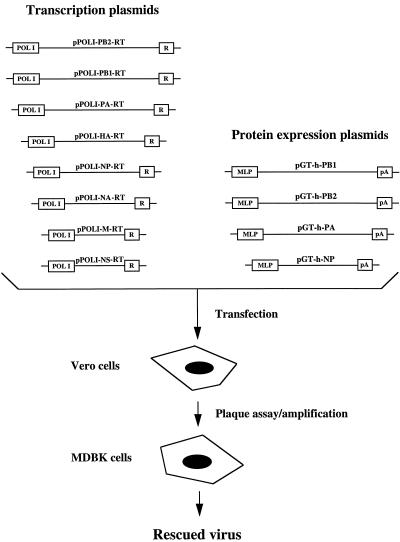FIG. 1.
Schematic representation of the plasmid-based rescue system for influenza A virus. The pGT-h set of protein expression plasmids was constructed by inserting the open reading frames of PB1, PB2, PA, and NP proteins into the BclI cloning site of the pGT-h plasmid (2). The PB1 and PA genes were derived from influenza A/WSN/33 virus. The PB2 and NP genes were derived from influenza A/PR/8/34 virus. The viral genomic sequences of influenza A/WSN/33 virus were cloned into pUC18- or pUC19-based plasmids between a truncated human RNA Pol I promoter (nt −250 to −1) (19) and sequences of the hepatitis delta virus ribozyme in an analogous way as described for pPOLI-CAT-RT (28). Genetic tags were inserted into the HA- and NA-encoding plasmids by using conventional mutagenic techniques. For viral rescue, 5 μg of each of the polymerase protein expression plasmids (pGT-h-PB1, pGT-h-PB2, and pGT-h-PA), 10 μg of the NP-expressing pGT-h-NP, and 3 μg of each of the eight vRNA-coding transcription plasmids (pPOLI-PB2-RT, pPOLI-PB1-RT, pPOLI-PA-RT, pPOLI-HA-RT, pPOLI-NP-RT, pPOLI-NA-RT, pPOLI-M-RT, and pPOLI-NS-RT) were diluted to a concentration of 0.1 μg/μl in 20 mM HEPES buffer (pH 7.5). The DNA solution was added to diluted DOTAP liposomal transfection reagent (Boehringer) containing 240 μl of DOTAP and 720 μl of 20 mM HEPES buffer (pH 7.5). The transfection mixture was incubated at room temperature for 15 min, mixed with 6.5 ml of MEM containing 0.5% fetal calf serum, 0.3% bovine serum albumin, penicillin, and streptomycin and added to near-confluent Vero cells washed with phosphate-buffered saline in 8.5-cm dishes (about 107 cells). At 24 h after transfection, the transfection mixture was removed and the cells were incubated with 8 ml of fresh medium, which was replaced daily for 4 days. The harvested medium from transfected dishes was screened for rescued influenza virus by plaquing and amplification on MDBK cells. POL I, truncated human RNA polymerase I promoter; R, genomic hepatitis virus ribozyme; MLP, adenovirus type 2 major late promoter; pA, polyadenylation sequence from SV40.

